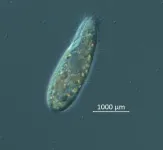(Press-News.org) MADISON – Today, foldable phones are ubiquitous. Now, using models that predict how well a flexible electronic device will conform to spherical surfaces, University of Wisconsin–Madison and University of Texas at Austin engineers could usher in a new era in which these bendy devices can integrate seamlessly with parts of the human body.
In the future, for example, a flexible bioelectronic artificial retina implanted in a person’s eyeball could help restore vision, or a smart contact lens could continuously sense glucose levels in the body.
“With our powerful simulation model, we can now predict the conformability immediately, which dramatically speeds up the design process for flexible electronics,” says Ying Li, an associate professor of mechanical engineering at UW–Madison, whose research group developed the computational models. “The simulation results give very clear guidance for experimentalists, who can now determine the optimal design without needing to do a lot of extremely time-consuming experiments.”
The researchers detailed their work in a paper published April 19, 2023, in the journal Science Advances.
To perform as expected, bioelectronic devices must make very close contact with living tissue and avoid buckling or creasing. However, researchers have struggled to get flexible electronics to fully conform to so-called “non-developable surfaces” — surfaces such as spheres that can't be flattened without breaking or creasing — which are all over the human body.
In this study, the research team used a combination of experimental, analytical and numerical approaches to systematically investigate how circular polymer sheets (which mimic the mechanical properties of flexible electronics), as well as partially cut circular sheets, conform on spherical surfaces. Analyzing those results enabled the researchers to derive a ready-to-use formula that reveals the underlying physics and predicts the conformability of flexible electronics.
“The results from our three different methods all pointed to the same physics, which is exciting,” says Nanshu Lu, a professor in the Department of Aerospace Engineering and Engineering Mechanics at the University of Texas at Austin, who led the experimental research. “We formulated a very simple mathematical equation to guide the design of flexible electronics for maximum conformability, and this should have a significant impact in the field.”
In addition, the researchers demonstrated a simple and elegant method for greatly enhancing the ability of flexible sheets to conform on spherical surfaces. Inspired by the Japanese art of kirigami, in which paper is cut and folded, the researchers made the simplest possible radial cuts in the circular sheet, improving its conformability from 40% to more than 90%.
Li says this advance will drive innovation in the field by enabling many other researchers to design improved flexible electronics.
“This is the first work to provide a full picture to understand the complex process of how flexible electronics conform to these complicated surfaces,” Li says. “This advance will pave the way for all the future studies in the area of developing bioelectronics that can better conform to the human body.”
Siyi Liu from UT-Austin and Jinlong He from UW–Madison are equal-contribution first authors of the Science Advances paper. Co-authors on the paper also include Yifan Rao and John Tanir from UT-Austin, Zhaohe Dai from Peking University, and Huilin Ye from the University of Connecticut.
The research was supported by grants from the U.S. Army Research Office and the National Science Foundation.
###
--Adam Malecek, acmalecek@wisc.edu
END
Deadly heatwaves fuelled by climate change in 2022 made almost 90 percent of Indians more vulnerable to public health issues, food shortages and increased risks of death, a new study from researchers at the University of Cambridge reported in PLOS Climate.
India currently uses a national Climate Vulnerability Indicator (CVI) to measure climate vulnerability and make plans for adaptation. The CVI includes many different socioeconomic, biophysical, institutional, and infrastructural factors. But it doesn't ...
There is a growing body of evidence that iron in the brain may play a role in Alzheimer’s disease. Lending weight to that idea, a new imaging probe has for the first time shown that in the same regions of the brain where the amyloid beta plaques associated with Alzheimer’s occur, there is also an increase in iron redox, meaning the iron in these regions is more reactive in the presence of oxygen. Their imaging probe could yield even more details about the causes of Alzheimer’s and help in the search for new drugs to treat it.
A ...
TAMPA, Fla. (APRIL 19, 2023) – The search for the 2022 killer that decimated the long-spined sea urchin population in the Caribbean and along Florida’s east coast is over. A team of researchers organized by Mya Breitbart, Distinguished University Professor at the University of South Florida’s College of Marine Science, identified a single-celled organism called a ciliate as the cause of a massive die-off event to a marine animal vital to coral reef health.
Their findings were reported in Science Advances.
“We’re beyond ...
APRIL 19, 2023
As Covid roared through prisons in 2020, the U.S. prison population fell by as much as 30 percent, creating the largest, fastest reduction in prison population in American history. But this decarceration disproportionately benefited white incarcerated people, sharply increasing the fraction of incarcerated Black and Latino people. A new study in Nature shows that this increased racial disparity in U.S. prisons stems in large part from a long-standing problem with the justice system: Non-white people tend ...
HOUSTON ― The University of Texas MD Anderson Cancer Center’s Research Highlights showcases the latest breakthroughs in cancer care, research and prevention. These advances are made possible through seamless collaboration between MD Anderson’s world-leading clinicians and scientists, bringing discoveries from the lab to the clinic and back.
Recent developments include effective combination therapies for patients with BRAFV600E mutations, an approach to identify cancer biomarkers in extracellular vesicles, therapeutic strategies for improving ...
COLUMBUS, Ohio – As climate change causes ocean temperatures to rise, one of Greenland’s previously most stable glaciers is now retreating at an unprecedented rate, according to a new study.
Led by researchers at The Ohio State University, a team found that between 2018 and 2021, Steenstrup Glacier in Greenland has retreated about 5 miles, thinned about 20%, doubled in the amount of ice it discharges into the ocean, and quadrupled in velocity. According to the study, such a rapid change is so extraordinary ...
The Container Store, the nation’s leading retailer of storage and organization solutions, custom spaces, and in-home organizing services, will fund $10,000 in scholarships for Charisma™ Virtual Social Coaching, a strengths-based social skills training developed by Center for BrainHealth.
Charisma is a personalized, avatar-driven program that provides real-time, unscripted social coaching in a safe, non-threatening virtual environment. Drawing on extensive cognitive neuroscience research, this program is demonstrated to help people with social challenges to ...
A study led by Oak Ridge National Laboratory researchers identifies a new potential application in quantum computing that could be part of the next computational revolution.
The study surveys techniques for compressing data generated by sensors in edge computing — which processes data at or near sensors — and compares classical techniques with quantum approaches, which are mostly in development. Compressing data saves storage space and network bandwidth.
Classical computing stores information in bits equal to 0 or 1. Quantum computing stores information in qubits, which can exist ...
A treatment combining two antibodies against the coronavirus SARS-CoV-2 strongly protected high-risk people with early COVID-19 symptoms from hospitalization and death in an international Phase 2/3 clinical trial conducted in the first half of 2021 and co-led by researchers at Weill Cornell Medicine and NewYork-Presbyterian.
The trial, described in a paper appearing online Apr. 18 in Annals of Internal Medicine, enrolled more than 800 non-hospitalized patients with COVID-19 at high-risk of progression of the disease in the United States and ...
WASHINGTON, D.C.—April 19, 2023—The U.S. Department of Veterans Affairs (VA), the largest integrated healthcare system in the nation, today announced that 60 of its 111 emergency departments have earned Geriatric Emergency Department Accreditation (GEDA) from the American College of Emergency Physicians (ACEP). Another 11 departments are on track to earn the designation in coming months and the VA has plans to expand the program to the majority of its hospitals over the next three years.
Geriatric emergency departments provide specialized care to older veterans and their families during and after a ...



